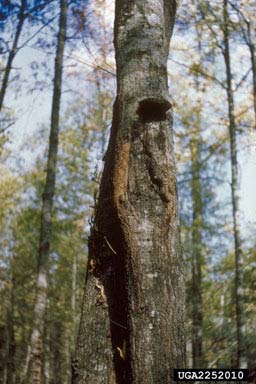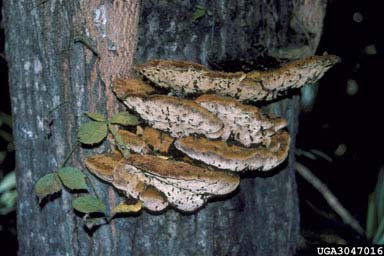
Importance: Diseases cause 45% of all mortality and degradation in the forests. Heart rot is the single most important disease of merchantable hardwood timber in the South, causing 75% of these losses. Heart rot can affect all parts of the tree, but frequently occurs in the butt log where its impact on the value of the tree is greatest. In the earlier stages, damage is in degraded wood. Advanced decays cause hollows, tree breakage, and mortality.
Identification: Damage from heart rot is easily observed through physical evidence of hollows, rotten wood, irregular or lumpy stems, cankers, cat-faces, scars, and fungus fruiting bodies on stems. Most begin at basal injuries, like those caused by fire and logging damage.
Different fungi may behave differently in timber stands by rate of decay and spread, and host species attacked. Canker-Rots are a serious form of hardwood decay, they are different from heartwood rot, because they kill the cambium layer and cause cankers. From the initial point of attack a Canker-Rot can spread through the cambium layer up to a half a foot a year, and the heart rot may exceed canker length by up to two and a half feet. Canker-Rots particularly attack southern red oaks, but will also attack other species. Trees are predisposed to decay by wounding caused by insects, weather, fire, animals, and human activity such as logging.

Prevention: Minimize decay by growing species adapted to the site and by preventing wounding. Carefully supervise fire control and prevention, road building, logging and other forest activities. When clearcutting for coppice regeneration, stumps should be cut as close to the ground as possible.

Control: Once the decay process begins, there is no control. When thinning hardwood stands for regeneration, remove all diseased trees. These fungi can continue to produce spores on dead trees for many years. If this is uneconomical, cut the tree and leave it on the ground to reduce inoculum dispersal. This also allows decay fungi to be over-run by decomposing fungi. Never put scar sealant over existing scars, because this may further promote decay.
Photo Credit: Theodore D. Leninger, USDA Forest Service; Missoula Archives, USDA Forest Service, ForestryImages.org
Additional Resources